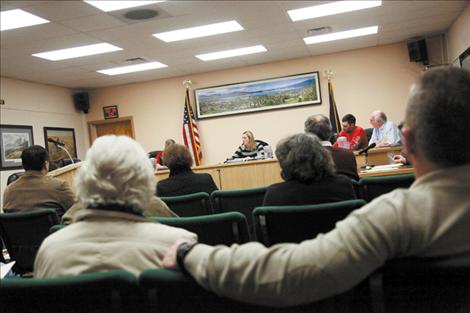Tribal, state attorneys share compact impact
Hey savvy news reader! Thanks for choosing local.
You are now reading
3 of 3 free articles.
POLSON — People expecting heated words and clashing opinions at the Feb. 3 Polson City Commission workshop meeting were instead treated to a civil presentation about how the water compact could impact the City of Polson’s municipal wells.
Melissa Hornbein, Reserved Water Rights Compact Commission staff attorney, and Dan Decker, Confederated Salish and Kootenai Tribes staff attorney spoke to the commissioners and the audience about the CSKT water compact pending in Montana State legislature.
Those in opposition declined the opportunity to present at the workshop, according to Mayor Heather Knutson so she amended the agenda at the start of the workshop.
Decker gave background on the Flathead Reservation. In 1855, the Hellgate Treaty was established, and the Confederated Salish and Kootenai Tribes were set aside an exclusive tribal homeland, Decker said.
Then in 1904, the United States Congress directed allotment of land to tribal members and allowed opening of surplus land to homesteading.
In 1970, the Montana legislature directed the Reserved Water Rights Compact Commission to work with the tribes and the United States to reach a negotiated settlement for their water rights claims.
“The CSKT settlement — what does it do?” Decker said. “First it protects existing verified water uses by the tribe, tribal members, allottees and non-Indians on the reservation and calls for the unified administration of all water rights on the reservation.”
The reason for a settlement is that all water rights on the reservation are going to go through adjudication with or without a settlement, he explained.
From the CSKT’s perspective, a settlement avoids the time, expense, risk and uncertainly of litigation, Decker added.
The RWRCC is bi-partisan with nine members, two appointed by the president of the Montana Senate, two by the speaker of the Montana House of Representatives, four members appointed by the governor of Montana and one by Montana’s attorney general.
“As you might be aware, Montana has finished six other compacts with the other reservations. The CSKT compact is the last one … probably because it’s the most complicated,” Decker said.
Part of the complicated nature is that the CSKT tribes are the only tribes with a Stevens Treaty, which have “strong language which affords tribes to hunt, fish and gather on aboriginal territories,” Decker said.
“Aboriginal Indian water rights differ from state water rights in significant ways,” Decker said. “First they generally carry a senior priority date. For the CSKT, that’s 1855; second, they can’t be lost to non-use and third, they provide for future use.”
Winters versus the United States is a court case heard by the United States Supreme Court in 1908 that’s an important piece of Montana water law.
It was a dispute over the waters of the Milk River between homesteaders who diverted water from the river and put it to beneficial use. The Fort Belknap tribes and the United States said under the Fort Laramie treaty, even though the treaty didn’t specifically mention water, it implied the tribes water right was senior to the homesteaders. The Supreme Court decided in the tribes’ favor and precluded the homesteaders from taking water out of the river.
Priority date is how Montana water rights are decided: first in line is first in time, according to Hornbein.
The proposed compact protects existing verified water users by the CSKT tribe, tribal members, allottees and non-Indians on the reservation.
Not only is the CSKT proposed compact the last, it’s also the only compact to be administered by a five-member joint tribal and state water management board, a key piece to preventing basin closure. Four out of the six other compacts have a closed basin because all the remaining available water was allocated as part of the tribal water rights.
To form this board, two members would be appointed by Governor Steve Bullock and two by the CSKT Tribal Council with the remaining member elected by the first four members. The board would oversee all aspects of all water on the reservation with the exception of the Flathead Indian Irrigation Project.
“The second really critical piece of compact settlement negotiations regarding municipal water rights and future use of municipal water is what is called Flathead system compact water rights,” Hornbein said. “It’s the single largest water right quantified under the compact — 229 thousand acre feet diverted, 128 thousand acre feet consumed. The water can be used for any beneficial use in the future. It can be leased by the tribes for any beneficial use, including municipal uses.”
The terms of the leases allow for up to 99 years with the ability to renew them, according to Hornbein, who said long-term leases would be of interest to cities.
This is critical, Hornbein said, because with or without a compact in place, it’s hard to develop a new use of water without going through the mitigation requirement under the Montana Use Act.
“All that means,” Hornbein said, “is if you come in and propose a new use, and apply for a permit to use water, if other users object and say, ‘No, your new water use is going to adversely affect my existing water right,’ then the applicant currently, under state law, is required to go through mitigation and show they have an alternative source of water to offset those negative impacts to existing uses.”
The Flathead system water — backstopped by 90,000 acre feet of water out of Hungry Horse Reservoir — has the ability to supply a significant source of mitigation water, according to Hornbein.
There are other ways to find mitigation water, she said. People can buy or lease someone else’s existing water right to use for mitigation water, but the Flathead system water is a “very large source of newly available water.”
During the question and answer session, Mayor Heather Knutson asked about the status of Polson’s seven water wells.
Hornbein said any pre-1973 claims for water rights need to go through statewide stream adjudication. Until the Montana Water Court examines them and gives a final decree, they are called claims.
“Adjudication of water rights have been stayed in this valley following 1996 cases, until the reservation of tribal water rights claims through negotiation or litigation,” Horbein said.
For pre-1973 uses, once adjudication starts, either with the compact or without, the claims would go through the water court examination process.
For post-June 1973 claims, the Department of Natural Resources and Conservation issued permits for use, these permits or claims are protected as existing uses under the terms of the compact.
Knutson also asked for clarification on the compact: “With or without the agreement, we will go through adjudication?”
The goal of adjudication is to correctly quantify and results in decrees of finalization of all the water rights in the state of Montana, Hornbein said.
“The critical difference,” she said, “is with the compact in place, the compact itself goes through the adjudication as a separate entity, rather than as a set of hundreds or perhaps thousands of individual different claims.”
Knutson also had questions about calling water rights.
“A senior user is entitled to the last drop of his water right before a junior user is entitled to first drop of his,” Hornbein said.
So, with a priority date of 1855 or time immemorial, CSKT water rights trump Polson’s municipal rights.
“I don’t want you to leave here with the false idea that there is either a settlement option or Polson would be in call by the tribes all the time. Typically municipalities are not highest on the target for senior water users to make a call on,” said Ethan Mace, hydrologist for the RWRCC.
The water compact bill began its journey through the Montana State Legislature on Feb. 3 as Senate Bill 262, or lc1999, to look it up on the Internet.



















